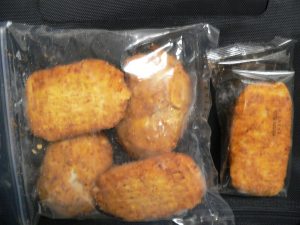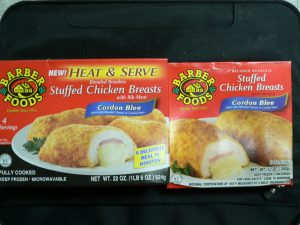The Public Health Agency of Canada says 474 people have gotta sick from raw frozen chicken thingies over the past year and a half.
 Over a decade ago, when I went to Kansas State, me and Chapman and Phebus came up with a project to see how people cooked these thingies.
Over a decade ago, when I went to Kansas State, me and Chapman and Phebus came up with a project to see how people cooked these thingies.
Why not cook all these thingies to reduce risk, because it costs about $0.01 a pound too cool these things with electricity.
The American Meat Institute funded it.
Some of these thingies are frozen raw, which means they have to be cooked in an oven and temperature verified with a tip-sensitive digital thermometer, and some of these thingies are pre-cooked, so can be thawed in a microwave.
Labelling has changed over the years, but it’s still necessary to know what you’re buying.
Some of the frozen raw products may appear to be pre-cooked or browned, but they should be handled and prepared with caution
I’d understand Australia, with its massive coal investments, but Canada and the U.S. where nuclear is readily available?
In May 2017, Government of Canada scientists began using a new technology called “whole genome sequencing” to help identify and respond to outbreaks. Over the past year and a half, federal, provincial and territorial health and food safety partners have investigated 14 national outbreaks linked to raw chicken, including frozen raw breaded chicken products. The Canadian Food Inspection Agency has issued food recall warnings for ten products linked to some of these outbreak investigations.
As of November 2, 2018, there have been 474 laboratory-confirmed cases of Salmonella illness investigated as part of the illness outbreaks across the country.
All active and future Salmonella outbreak investigations linked to raw chicken, including frozen raw breaded chicken products, and related food recall warnings will be listed in the next section of the public health notice to remind Canadians of the ongoing risk associated with these types of food products.
 Do not eat raw or undercooked frozen breaded chicken products. Cook all frozen raw breaded chicken products to an internal temperature of at least 74°C (165°F) to ensure that they are safe to eat. Use a digital food thermometer to verify the temperature. Insert the digital food thermometer through the side of the product, all the way to the middle. Oven-safe meat thermometers that are designed for testing whole chicken and roasts during cooking are not suitable for testing nuggets, strips or burgers.
Do not eat raw or undercooked frozen breaded chicken products. Cook all frozen raw breaded chicken products to an internal temperature of at least 74°C (165°F) to ensure that they are safe to eat. Use a digital food thermometer to verify the temperature. Insert the digital food thermometer through the side of the product, all the way to the middle. Oven-safe meat thermometers that are designed for testing whole chicken and roasts during cooking are not suitable for testing nuggets, strips or burgers.
Microwave cooking of frozen raw breaded chicken products—including chicken nuggets, strips, burgers, popcorn chicken or chicken fries—is not recommended because of the possibility of uneven heating.
Always follow the cooking instructions on the package, including for products labelled Uncooked, Cook and Serve, Ready to Cook, and Oven Ready.
Wash your hands thoroughly with soap and warm water before and after handling frozen raw breaded chicken products (the water does not need to be warm).
Always follow the cooking instructions provided on the package. Cook chicken to a safe internal temperature that has been checked using a digital thermometer. Raw chicken pieces should be cooked to an internal temperature of 74°C (165°F). Whole chicken should be cooked to an internal temperature of 82°C (180°F).
Keep raw chicken away from other food while shopping, storing, repackaging, cooking and serving foods.
A table of raw frozen chicken thingies outbreak is available at https://barfblog.com/wp-content/uploads/2014/06/Outbreaks-Associated-with-Raw-Frozen-Meals-4-13.xlsx.
Self-reported and observed behavior of primary meal preparers and adolescents during preparation of frozen, uncooked, breaded chicken products
01.nov.09
British Food Journal, Vol 111, Issue 9, p 915-929
Sarah DeDonder, Casey J. Jacob, Brae V. Surgeoner, Benjamin Chapman, Randall Phebus, Douglas A. Powell
http://www.emeraldinsight.com/Insight/viewContentItem.do;jsessionid=6146E6AFABCC349C376B7E55A3866D4A?contentType=Article&contentId=1811820
Abstract:
Purpose – The purpose of the present study was to observe the preparation practices of both adult and young consumers using frozen, uncooked, breaded chicken products, which were previously involved in outbreaks linked to consumer mishandling. The study also sought to observe behaviors of adolescents as home food preparers. Finally, the study aimed to compare food handler behaviors with those prescribed on product labels.
Design/methodology/approach – The study sought, through video observation and self-report surveys, to determine if differences exist between consumers’ intent and actual behavior.
Findings – A survey study of consumer reactions to safe food-handling labels on raw meat and poultry products suggested that instructions for safe handling found on labels had only limited influence on consumer practices. The labels studied by these researchers were found on the packaging of chicken products examined in the current study alongside step-by-step cooking instructions. Observational techniques, as mentioned above, provide a different perception of consumer behaviors.
Originality/value – This paper finds areas that have not been studied in previous observational research and is an excellent addition to existing literature.
